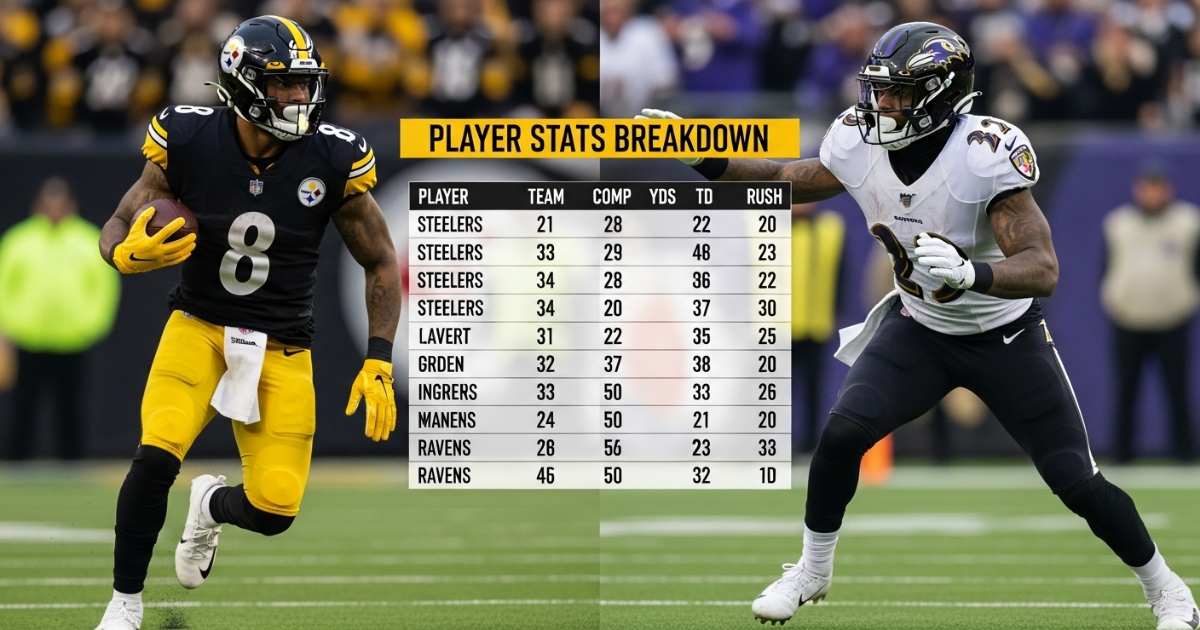The storied rivalry between the Pittsburgh Steelers and Baltimore Ravens has produced some of the most intense moments in the NFL. Their recent matchup in 2025 showcased not only their fierce competition but also individual player brilliance and critical game strategies. This breakdown will dissect player performances, team strategies, and the game’s pivotal moments, highlighting the factors that contributed to the Steelers’ triumph.
1. Quarterback Performances That Defined the Match
Kenny Pickett’s Stellar Performance
Kenny Pickett, the Steelers’ young quarterback, stepped into the spotlight during this high-stakes matchup. With 23 completions on 34 attempts, he threw for 254 yards, including two touchdowns and one interception. What stood out most was his poise under pressure and his ability to make crucial decisions, especially during third downs and the game-winning drive.
Pickett’s performance included:
- Accuracy: Completing roughly 67.6% of his passes.
- Third Down Efficiency: He was key in converting critical third downs, keeping drives alive.
- Decision Making: His only interception came against a well-timed defensive play but didn’t overshadow his overall effectiveness throughout the game.
Lamar Jackson’s Dual-Threat Capability
On the other side, Lamar Jackson showcased his renowned dual-threat ability. He completed 21 of his 30 passes for 240 yards, along with one touchdown and one interception. His contribution was further amplified by 64 rushing yards.
Key highlights from Jackson’s performance:
- Pass Completion Rate: Jackson’s 70% completion rate exemplified his accuracy.
- Rushing Threat: His ability to scramble kept the Steelers’ defense guessing, although he succumbed to critical mistakes that swayed momentum.
- Crucial Errors: Late in the game, a costly fumble and interception shifted the gameplay, leading to Steelers’ scoring opportunities.
2. Running Backs: Power and Precision on Display
The success of any game often hinges on the effectiveness of its running game. For the Steelers and Ravens, running backs played pivotal roles in establishing control on the ground.
Najee Harris’ Impact
Najee Harris emerged as a focal point for the Steelers, rushing for 92 yards on 18 carries and scoring a crucial third-quarter touchdown. His physical running style wore down the Ravens’ defensive front, allowing the Steelers to maintain offensive momentum.
- Rushing Average: Harris averaged 5.1 yards per carry, significant in tight matchups.
- Key Plays: His ability to gain crucial yards in critical situations was invaluable.
Gus Edwards’ Contributions
For the Ravens, Gus Edwards led the ground game with 76 yards on 15 attempts. While he was efficient, the Ravens needed more explosive plays to swing momentum.
- Rushing Dynamics: His efforts, however, were hampered by Pittsburgh’s aggressive defensive front, limiting his ability to break away for larger gains.
3. Wide Receiver Highlights and Key Contributions
Wide receivers often frame the narrative of a game, and this matchup was no exception. Their performances were essential in stretching defenses and converting vital downs.
George Pickens: Star Receiver for the Steelers
George Pickens shone bright for Pittsburgh, recording 7 receptions for 118 yards and a touchdown. His dynamic play was instrumental in keeping the Ravens’ defense on edge.
- Big Play Ability: Pickens utilized his speed and agility to create mismatches, proving to be Pickett’s top target.
- Game Impact: His touchdown reception showcased his capability to perform under pressure.
Zay Flowers: Bright Spot for the Ravens
On the Ravens’ side, Zay Flowers proved to be a reliable option, contributing 6 catches for 84 yards. His route-running ability kept drives alive at critical moments.
- Sustaining Drives: Flowers’ ability to gain separation was evident, though inconsistency plagued the Ravens’ receiving corps.
- Dropped Passes: Despite his solid performance, dropped passes from other receivers negatively impacted the Ravens’ offensive flow.
4. Tight Ends and Their Silent but Crucial Impact
The tight ends in this game may not have received the spotlight, but their contributions were crucial in pivotal moments.
Pat Freiermuth’s Role
Pat Freiermuth played a significant role for the Steelers, catching 4 passes for 46 yards. His ability to pick up crucial first downs kept Pittsburgh’s momentum flowing.
- Clutch Situations: Freiermuth’s catch on third-and-long demonstrated his importance in high-pressure moments.
Mark Andrews’ Performance
Mark Andrews was also a consistent target for Jackson, recording 5 receptions for 58 yards. However, the Steelers’ defense limited his impact precisely when it mattered.
- Coverage Challenges: Andrews struggled against tight coverage in the red zone, which restricted his ability to contribute significantly to the scoreline.
5. Offensive Line Performance and Protection Stats
Steelers’ Offensive Line Success
The Steelers’ offensive line effectively protected Kenny Pickett, allowing only 2 sacks and providing him ample time to read the field.
- Protection Stats: Their pass protection was critical, ensuring that Pickett had the time to connect with his receivers.
- Run Blocking: The line’s ability to open up lanes for Harris contributed greatly to the ground game.
Ravens’ Blocking Struggles
Conversely, the Ravens’ offensive line faced significant challenges. They surrendered 4 sacks and allowed 9 quarterback pressures, which affected Jackson’s performance.
- Timing Disruption: The relentless pressure caused hurried throws, leading to turnovers and missed opportunities.
6. Steel Curtain: Defensive Standouts for Pittsburgh
The Pittsburgh Steelers’ defense returned to form, exemplifying characteristics reminiscent of their famous “Steel Curtain” era.
T.J. Watt’s Dominance
T.J. Watt was a standout, registering 2.5 sacks, 5 tackles for loss, and a forced fumble that sealed the victory late in the game.
- Defensive Impact: His ability to make game-changing plays was vital in disrupting Baltimore’s rhythm.
- Play Recognition: Watt’s instinctual play-calling allowed him to exploit gaps and apply pressure effectively.
Additional Defensive Contributors
Minkah Fitzpatrick also played a critical role, notching 7 tackles and a pivotal interception that swung momentum back to the Steelers.
- Team Dynamics: Other contributors, including Alex Highsmith and Cole Holcomb, applied constant pressure, effectively stifling the Ravens’ offensive progression.
7. Ravens’ Defensive Resistance and Grit
Despite a challenging outing, the Ravens showed resilience on defense, with standout performances contributing to their effort.
Roquan Smith’s Tenacity
Roquan Smith was everywhere on the field, totaling 12 tackles and forcing a fumble in the process.
- Leadership and Physicality: His tenacity kept the Ravens competitive even when facing strong offensive plays from the Steelers.
Kyle Hamilton’s Contribution
Kyle Hamilton also shone brightly, recording 6 solo tackles and making critical pass breakups that prevented additional scoring opportunities.
- Defensive Strategies: Despite individual performances, collective lapses on third downs hindered the Ravens’ ability to contain Pittsburgh’s drives.
8. Special Teams: Hidden Stats with Huge Impact
Chris Boswell’s Consistent Performance
Special teams often get overlooked, but Chris Boswell’s contribution was pivotal. He was perfect on the night, completing 3 of 3 field goals, including a crucial 49-yarder.
- Impactful Kicking: Boswell’s reliability helped ensure scoring opportunities during crucial moments, contributing significantly to the final score.
Justin Tucker’s Miss
In contrast, future Hall of Famer Justin Tucker had a surprising miss on a 51-yard attempt – his first miss of the season.
- Momentum Shift: This miss potentially changed the game’s trajectory, underscoring the importance of special teams in tight contests.
9. Crucial Turnovers and Game-Changing Plays
Turnovers were another significant factor that heavily influenced the game’s outcome. The Steelers capitalized on the Ravens’ mistakes, winning the turnover battle.
Turnover Statistics
- Steelers’ Advantage: The Steelers intercepted Jackson once and recovered a fumble, leading to direct scoring opportunities.
- Ravens’ Misfortune: Conversely, Baltimore failed to capitalize on Pickett’s interception, frustrating their offensive strategy.
Game Impact
Every takeaway mattered in this closely contested battle, and the Steelers’ ability to convert these opportunities into points made a considerable difference in the outcome.
10. Third-Down Efficiency and Drive Sustainability
Controlling the game’s tempo requires success on third downs, and this matchup highlighted that disparity.
Statistical Analysis
- Steelers: Converted 53% of their third downs (7 of 13), showcasing their ability to sustain drives.
- Ravens: Managed only 36% third-down conversions, which stalled their offensive momentum.
Impact on Time of Possession
Pittsburgh’s effectiveness in converting third downs allowed them to dominate time of possession, leading to a more controlled pace and increased defensive strain on the Ravens.
11. Red Zone Execution and Play Calling
The ability to execute in the red zone often determines the outcome of close games.
Comparison of Red Zone Strategies
- Steelers’ Success: The Steelers converted 3 of 4 red zone trips, demonstrating effective play-calling and execution.
- Ravens’ Struggles: Baltimore managed to enter the red zone three times but only produced one touchdown, reflecting on missed opportunities.
Defensive Challenges
The Steelers’ defense tightened significantly in the red zone, forcing the Ravens into difficult situations and undermining their scoring potential.
12. Game-Winning Drive Breakdown
The pivotal moment of the game came in the fourth quarter, with a remarkable drive that cemented the Steelers’ victory.
Key Sequence of Plays
This 12-play, 78-yard drive culminated in a touchdown pass from Pickett to Pickens. The sequence was characterized by:
- Perfect Clock Management: The Steelers effectively managed the game clock, ensuring the Ravens had limited time to respond.
- Key Third-Down Conversions: Several crucial third-down conversions highlighted the offense’s rhythm and preparation under pressure.
Strategic Execution
The drive showcased the growth of Pickett as he effectively led his team, proving he can deliver in high-stakes situations.
13. Full Team Player Stats Table
| Player Name | Team | Key Stats |
|---|---|---|
| Kenny Pickett | Steelers | 254 YDs, 2 TDs, 1 INT |
| Lamar Jackson | Ravens | 240 YDs, 1 TD, 1 INT, 64 Rush YDs |
| Najee Harris | Steelers | 92 Rush YDs, 1 TD |
| George Pickens | Steelers | 118 YDs, 1 TD |
| Zay Flowers | Ravens | 84 YDs, 0 TD |
| T.J. Watt | Steelers | 2.5 Sacks, 5 TFL, 1 FF |
| Roquan Smith | Ravens | 12 Tackles, 1 FF |
14. Key Takeaways from the Match
As the dust settles from this electrifying matchup, several key takeaways emerge:
- Kenny Pickett demonstrated maturity and the ability to lead in crunch time.
- T.J. Watt’s dominance on defense was a game-changer, impacting offensive flow for the Ravens.
- The disparity in third-down conversions was crucial in dictating game pace.
- Baltimore’s failures in the red zone and on special teams ultimately cost them the game, reinforcing that every point counts in tight matchups.
Conclusion: Steelers Prevail in a Classic AFC North Showdown
The 2025 matchup between the Pittsburgh Steelers and Baltimore Ravens will be remembered as a dramatic testament to the intense nature of their rivalry. With strategic plays, standout performances, and game-changing moments, the Steelers emerged victorious, solidifying their place in the AFC North race.
As both teams look ahead to future matchups, this game highlighted areas for growth and improvement. For the Steelers, the future looks bright under the leadership of Pickett, while the Ravens must address their red zone efficiency and make necessary adjustments to capitalize on opportunities.
FAQs
Who was the standout player for the Pittsburgh Steelers in the game?
T.J. Watt emerged as the standout player, registering 2.5 sacks, 5 tackles for loss, and a game-sealing forced fumble.
How did Kenny Pickett perform in the match?
Kenny Pickett showcased poise and composure, completing 23 of 34 passes for 254 yards, with 2 touchdowns and 1 interception.
What was the key difference in third-down conversions between the two teams?
The Steelers converted 53% of their third downs compared to the Ravens’ 36%, allowing Pittsburgh to sustain drives and control the game tempo.
How did special teams impact the outcome of the game?
Special teams played a crucial role; Chris Boswell made all 3 of his field goal attempts, while Justin Tucker missed a pivotal 51-yard attempt.
What caused the Ravens to lose despite solid individual performances?
Key reasons for the Ravens’ loss included missed red zone opportunities, a negative turnover margin, and struggles on third-down defense despite individual highlights from players like Lamar Jackson and Roquan Smith.

